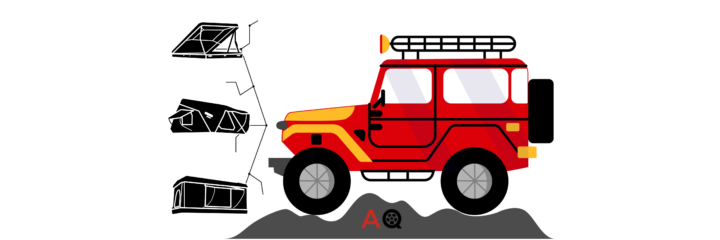The roof top tent first became popular with off-road adventurers in the Australian outback who’d protect themselves from venomous snakes and spiders crawling around the ground. And although our Aussie ‘mates’ from down under kick-started the craze, the innovative camping accessory is becoming increasingly popular in America for the convenience it affords.
Unlike conventional tents that sit firmly on the ground, roof top tents are mounted on the roof racks of your ride, which keeps you safe from perilous creatures, not to mention mud and snow. Should you opt for a super sturdy hard shell model, you’ll enjoy ample protection from the wind as well.
They may cost a tidy sum to purchase outright, but the hard shell roof top tent is a happy camper’s dream. In this buyer’s guide, we’re going to cover everything you need to know about their revolutionary design and round out the top 10 options on the market.
- Choosing the Right Hard Shell Roof Top Tent
- Top 8 Best Hard Shell Roof Top Tents 2025
- 1. Best Overall Pick: TMB Hard Shell Pop-Up Roof Tent
- 2. Best Premium Pick: iKamper SkyCamp 2.0
- 3. Best Budget Pick: DANCHEL OUTDOOR Rooftop Tent
- 4. Best for Summer: James Baroud Explorer
- 5. Best Storage: TEPUI HyBox
- 6. Best for Rough Weather: Alu-Cab Expedition 3
- 7. Most Comfortable: Pittman Outdoors Comet
- 8. Best Removable Tent: Roost Explorer
- Hard Shell Roof Top Tent Buyer’s Guide
- Hard Shell Roof Top Tents Versus Soft Shell Roof Top Tents
- The Benefits of a Hard Shell Roof Top Tent
- The Disadvantages of a Hard Shell Roof Top Tent
- The Different Types of Hard Shell Roof Top Tents
- Setting up and Packing Down a Hard Shell Roof Top Tent
- Maintaining a Hard Shell Roof Top Tent
- Hard Shell Roof Top Tent FAQs
- Hard Shell Roof Top Tents: The Ultimate Camping Accessory
Choosing the Right Hard Shell Roof Top Tent
Before you start shopping for a hard shell roof top tent of your very own, it’s essential to factor in a few crucial considerations. Keep the following six points in mind to ensure you purchase the best possible product for your needs. If a hard shell isn’t a requirement, you can also see our full rundown of roof top tents here.
Capacity
Hard shell roof top tents typically cater to two to three campers, although three adults in the one tent is almost always a squeeze. Make sure you purchase a model with plenty of space to fit everyone in.
Type
Hard shell roof top tents come in two major types: wedge-style and pop-ups. Wedge-style tents take longer to erect but provide more space and weather protection, while pop-up tents are more convenient but smaller.
Weight
Your roof racks have weight limitations, so ensure your hard shell tent (and the campers within) won’t exceed these. You can always upgrade your roof racks to a sturdier, after-market option, but you’ll need to factor the additional expense into your budget.
Size
You need to buy a tent that’s appropriate for the size of your vehicle and your roof racks. If you’ve got your heart set on a particular product that doesn’t quite fit, you can remove your factory-standard roof racks and replace them with something bigger.
Storage
Some options allow extra storage on top of the hard shell, while others let you remove the tent entirely and use the shell for storage. If you need more storage space, then choose a product that affords extra room.
Aerodynamics
Attaching anything to the roof of your car creates drag, thus requiring more energy from your engine and reducing your miles per gallon. Hard shell roof top tents feature an aerodynamic design to mitigate the issue, although some are better than others.
Price
Compared to a regular tent, hard shell roof top tents will set you back a pretty penny. With prices ranging from $1,000 to $4,000, your budget will play a major role in the decision-making process.
Now that you have some idea of what to look for, here are our favorite hard shell roof top tents for 2025.
| Product | Capacity | Type | Weight | Size | Rating |
|---|---|---|---|---|---|
| TMB Hard Shell Pop-Up Roof Tent | Two | Pop-Up | 200 lbs. | 84 x 49 x 13 inches | 5 |
| iKamper SkyCamp 2.0 | Two | Wedge | 155 lbs. | 54 x 86 x 13 inches | 5 |
| DANCHEL OUTDOOR Rooftop Tent | Three | Pop-Up | 144.7 lbs. | 82 x 51.5 x 14 inches | 5 |
| James Baroud Explorer | Two | Pop-Up | 200 lbs. | 55 x 78 x 13.2 inches | 4.5 |
| TEPUI HyBox | Two | Pop-Up | 177 lbs. | 84 x 55 x 12.75 inches | 4.5 |
| Alu-Cab Expedition 3 | Two | Wedge | 170 lbs. | 90 x 55 inches | 4 |
| Pittman Outdoors Comet | Two | Pop-Up | 172 pounds | 84 x 51 x 14 inches | 4 |
| Roost Explorer | Three | Wedge | 163 lbs. | 90 x 57 x 13 inches | 3.5 |
Top 8 Best Hard Shell Roof Top Tents 2025
1. Best Overall Pick: TMB Hard Shell Pop-Up Roof Tent
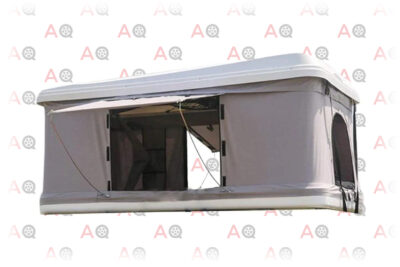
Editor’s Rating:
Quick Facts:
- Capacity: Two
- Type: Pop-Up
- Weight: 200 lbs.
- Size: 84 x 49 x 13 inches
Whether you’re new to the world of roof top camping or you just want a simple, well-rounded tent that works, this hard shell pop-up from TMB is hard to beat.
Coming in at around the $2k mark, it has outstanding value for weekend campers with modest needs. One of the things we love most about this model is just how quickly and easily it unfurls—pop-out the shell, and it’s ready to go in 30 seconds flat thanks to the shock assisted arms. Inside, you’ll find a smorgasbord of nifty features, some of which are often reserved for premium roof top tents: bungee nets, inner/outer zippers, side pouches, etc. The sturdy telescopic ladder makes you feel safe and stable when you’re climbing in and out of the thing.
It’ll fit most standard-sized roof racks, and at 200 lbs., the slender tent is a fair bit lighter than most. It’s relatively quiet, too, as you can barely hear the wind rattling the shell, even while hurtling at 70mph down the freeway. And if high school science 101 taught us anything, that means there’s not much wind resistance; therefore, little difference in fuel efficiency when driving with this tent mounted.
Granted, it won’t compete in terms of durability, weather resistance, or comfort with the high-end models. But if you’re a casual camper, you don’t need all that much, and the savings are well worth it. Also, while the included memory foam mattress isn’t terrible, it’s certainly not as luxuriously comfortable as some of our other options.
Pros
- Moderately priced
- Easy to set up and pack down
- High-quality design
- Low wind drag while driving
- Great for casual campers
Cons
- Doesn’t compete with high-end tents
- The included mattress could be better
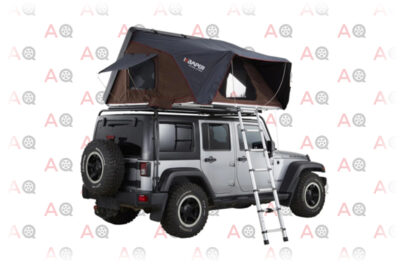
Editor’s Rating:
Quick Facts:
- Capacity: Two
- Type: Wedge
- Weight: 155 lbs.
- Size: 54 x 86 x 13 inches
You’ll pay a pretty penny for the privilege, but the SkyCamp 2.0 is well worth the investment for keen campers after a spacious hard shell wedge-style tent. A sturdy base folds out the side of your vehicle to create a great big platform of 83 x 86 x 43 inches, enough to sleep three full-sized adults comfortably. Families are particularly enamored with this roomy option as you could easily squeeze in two adults and two pre-teen kids.
Aside from the size, iKamper has hit the nail on the head by producing a sturdy and durable tent built to withstand the elements. A thick FRP and polyester/canvas does a brilliant job of protecting campers from the wind and the rain, while its heavily insulated base gets them all cozy and snug during those frigid early mornings.
Given this high-end tent is quite a significant investment, you might rightfully feel worried about someone taking off with the thing. But you needn’t because iKamper includes a theft-proof lock with the design, which also safeguards the possessions within (worth it for the peace of mind alone).
You may find the previous model—the SkyCamp 1.0—cheaper online. But the downgrade isn’t worth it, in our opinion, as the 2.0 is significantly sturdier and more spacious. Furthermore, the new and improved latching mechanism makes set up and break down easier than ever before. Having said that, it does take a few minutes longer than your average pop-up style hard shell tent, but the extra effort is worth it for the abundance of space.
Pros
- Large spacious design
- Sleeps up to three adults (or two adults and two kids)
- Sturdy build
- Excellent weather resistance
Cons
- Takes longer to assemble than a pop-up tent
- Rather expensive
3. Best Budget Pick: DANCHEL OUTDOOR Rooftop Tent
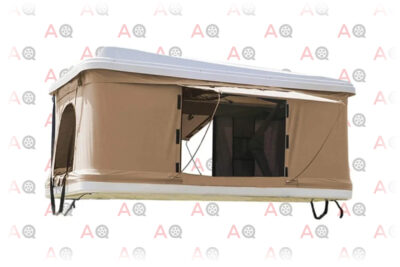
Editor’s Rating:
Quick Facts:
- Capacity: Three
- Type: Pop-Up
- Weight: 144.7 lbs.
- Size: 82 x 51.5 x 14 inches
If you’re in love with the concept of a hard shell roof top tent—and you should be—but you don’t want to fork out for the TMB Beige Hard Shell Pop Up Roof Tent, then this model from DANCHEL OUTDOOR is an outstanding alternative at a far lower price point. It costs about 25% less than the aforementioned model, which equates to significant savings you can dedicate to other essential camping gear.
The first thing you should know about this tent is that it’s designed for cars (or the bed of a pick-up truck), meaning you don’t need a beefy SUV to support the frame. With a maximum load rating of 570 lbs., you can fit up to three relatively slender humans inside—perfect for a fun-filled road trip with your two BFFs. Fly screen-clad windows on every wall ensure it won’t get too hot and stuffy inside (just as well if you’re cramming three people in there).
The weather resistance is pretty decent for a roof top tent in this price range, although we do recommend looking elsewhere should you frequently brave harsh temperatures or heavy rain. The mattress could also be a little comfier, but that’s easy enough to fix by adding a layer of your own.
Another downside is that although relatively light, the weight of the tent will affect the center of gravity on smaller cars, so you’d best take it easy when maneuvering around tight corners.
All in all, however, it’s a fantastic little budget option that’s perfect for campers who get around in a car rather than an SUV.
Pros
- Low-cost hard shell option
- Designed for use with cars
- Fits three people
- Decent weather resistance
Cons
- Notable effect on the center of gravity
- Included mattress isn’t the best
4. Best for Summer: James Baroud Explorer

Editor’s Rating:
Quick Facts:
- Capacity: Two
- Type: Pop-Up
- Weight: 200 lbs.
- Size: 55 x 78 x 13.2 inches
If you plan to do most of your camping in the sweltering summer months, you need to snag yourself a tent that won’t have you dripping with sweat throughout the night. And ventilation is where the James Baroud Explorer excels with a breeze-inducing design and a solar-powered cooling system.
Unlike most roof top tents, the Explorer has two entrance points plus a whole host of windows made of lightweight mesh to bring in the breeze. Should it start raining at any point during the night, it’s super easy to lean out and unfurl the fly, which provides plenty of protection from light to heavy rain. The polyester walls are also adequately waterproof and have a breathable design to optimize air-flow. To top off the high-end ventilation system, a solar-powered fan cycles air through the tent to cool you down, running for up to 24 hours on a single charge.
Extra storage is another nifty plus, with plenty of nets inside to stow your gear. Furthermore, regardless of whether the tent is up or down, you can store up to 65 lbs. of equipment on the roof, which is best attached using tie-down straps.
As is typical for a pop-up tent, there isn’t a tremendous amount of space within. Two adults can lie comfortably side-by-side, but it’s a bit cramped should one be over six foot tall (the open dimensions are 55 x 78 x 40 inches).
The product is pretty pricey as far as hard shell tents go, but definitely worth considering for passionate summertime campers.
Pros
- Plenty of breathable mesh
- Solar-powered fan is suitable for hot weather
- Good rain resistance
- Storage space inside and on roof
Cons
- A bit too tight for tall people
- Expensive
5. Best Storage: TEPUI HyBox
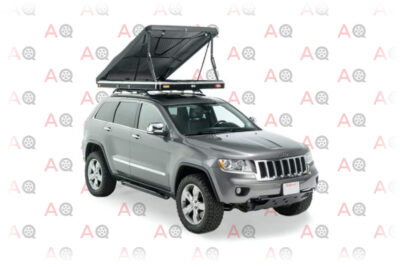
Editor’s Rating:
Quick Facts:
- Capacity: Two
- Type: Pop-up
- Weight: 177 lbs.
- Size: 84 x 55 x 12.75 inches
Tent specialist TEPUI makes a variety of roof top options, and this two-person model is among their best. The highly innovative design transforms the spacious tent into a useful cargo box—perfect for handymen who need somewhere to stash their tools. There is one rather unusual caveat to the design; however, the cargo box cannot be locked (don’t leave your best tools in there).
When you’re not using it for storage, the tent serves as a mighty fine place to sleep. Extra thick, reinforced insulation lines the interior to keep you cozy and reduce the rustling sound as the wind starts to pick up. Down below, honeycomb panels and a felt-lined aluminum frame give the tent a nice sturdy feel. What’s more, the 3000mm polyester material offers a high degree of waterproofing, so feel free to grab this model for your next trip to the Pacific Northwest.
The tent works well with most modern SUVs on the market, although you should double-check whether your roof racks are up for the job.
Pros
- Serves as both storage and tent
- Excellent waterproofing
- Sturdy frame
- Fits most SUVs and pick-ups
Cons
- Storage area can’t be locked
6. Best for Rough Weather: Alu-Cab Expedition 3
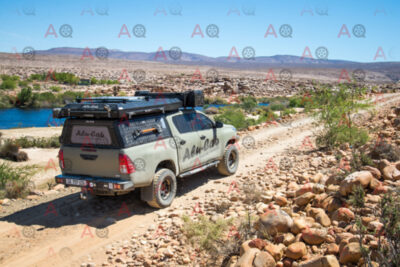
Editor’s Rating:
Quick Facts:
- Capacity: Two
- Type: Wedge
- Weight: 170 lbs.
- Size: 90 x 55 inches
The South African-based brand Alu-Cab is responsible for this heavy-duty hard shell, which is seen on remote wildlife expeditions (hence the name) throughout the wild continent. Safari tour companies love it for the durable and sturdy design, which allows them to get heavy use out of the investment over a lengthy timeframe.
The ultra-durable design is thanks to the aluminum frame, which can withstand stacks of weight and won’t break anytime soon. Gas-pressure springs make packing it up and down a breeze, especially compared to some of the other wedge-style tents on the market.
On the floor, a heavily insulated closed-cell polyethylene foam help reduce condensation and regulate the indoor temperature. Layered on top is a super soft, high-density foam mattress that provides ample comfort for even the fussiest camper.
Storage is another definite plus (you need plenty on an African safari). Pockets inside the tents are great for stashing your stuff, and there’s room on the roof to tie-down extra gear.
The product does well in wet weather, with a strategic pointed design (the outer shell is wider than the tent) that forces rain to flow down to the ground rather than seeping through the fabric. What’s more, each seam has been individually waterproofed, so you won’t have to worry about waking up damp—no need to “curse the rains down in Africa” in this tent.
Of course, quality products are always going to cost more, and you may have to do quite a lot of camping in this one to justify the expense.
Pros
- Sturdy and long-lasting
- Easy to pack down and set up
- Comfortable mattress
- Good insulation
- Does well in wet weather
Cons
- Expensive
7. Most Comfortable: Pittman Outdoors Comet
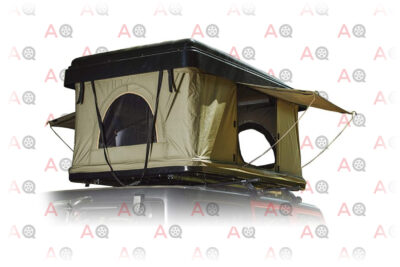
Editor’s Rating:
Quick Facts:
- Capacity: Two
- Type: Pop-up
- Weight: 172 pounds
- Size: 84 x 51 x 14 inches
A growing name on the outdoor adventure scene, Pittman has developed a small but loyal contingent of fans by providing quality craftsmanship at a reasonable price. The Comet is one such product, with a durable wind-resistant and waterproof design, it’s well equipped to withstand the rigors of Mother Nature. Included in the package is a heavy-duty telescopic ladder, which doesn’t feel the slightest bit flimsy when climbing up or down.
Inside, the insulated aluminum honeycomb base makes the frame feel sturdy and tort, while a non-deforming foam mattress means a good night’s sleep is all but guaranteed. The tent has been designed with longevity in mind; you can expect it to last for years (or decades) to come.
As you’d expect from a good hard shell roof top tent, the Comet is super easy to set up and pack away. After your first or second go, it should only take you a matter of minutes to get the process down pat.
All in all, it’s a respectable mid-range product that ticks all the boxes for casual campers and weekend warriors. If you’re a frequent or hardcore camper, however, then it might be worth investing a bit more in a premium product.
Pros
- Sturdy base
- Good water and wind resistance
- Comfy non-deforming foam mattress
Cons
- Not ideal for frequent campers
8. Best Removable Tent: Roost Explorer
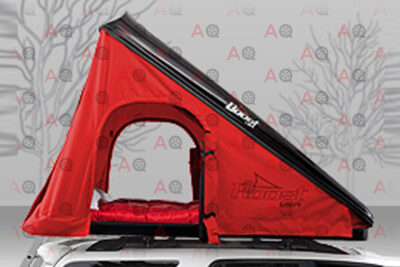
Editor’s Rating:
Quick Facts:
- Capacity: Three
- Type: Wedge
- Weight: 163 lbs.
- Size: 90 x 57 x 13 inches
This well-made and ultra-comfy wedge-style roof top tent has one unique feature that sees it stand out from the rest: you can take the tent out and use the hard shell for storage.
The entire tent—including its two-inch foam mattress—is designed to quickly and easily slide out of the shell, affording you a roomy 90 x 57 x 13 inches of space to stow your stuff. Skis, snowboards, small surfboards, and a range of other long sporting goods and other items fit inside, which is super convenient if you’ve got minimal boot space.
Storage aside, the Roost Explorer is a good roof top tent that provides ample comfort in a variety of conditions. Three screen-mesh doors bring plenty of air-flow into the cabin, and its spacious design can accommodate up to three adults (it’s more comfortable with two, though). On the floor, a two-inch high-density foam mattress is suitable for shorter trips, but we’d recommend upgrading to the three-inch mattress ($100 extra) if you’re planning on spending a lot of time inside the thing—you can’t put a price on a good night’s sleep, after all.
It does a respectable job of withstanding the elements thanks to its 600 Denier Solution Dyed Polyester fabric, although it’s perhaps not quite as good as some of our premium recommendations. Gas-pressure struts allow the contraption to open with ease, and it firmly attaches to your roof racks via lockable rear latches to reduce road noise and optimize gas mileage.
Switch to the Roost Sportsman model if you’d rather have a masculine camouflage print.
Pros
- You can use it as storage or a tent
- Good air-flow
- Spacious design
- Minimal road noise and good MPG
Cons
- Not as weather-resistant as other options
Hard Shell Roof Top Tent Buyer’s Guide
We won’t sugar coat it: hard shell roof top tents are a significant investment, so expect to spend thousands of dollars on your elevated campsite.
Considering you’ll be dropping such a substantial sum, it’s well worth learning everything you can about the product beforehand. That’s where this in-depth buyer’s guide comes in, with oodles of thoroughly researched information to help you wrap your head around the hard shell roof top tent. Paired with other supplies like an electric cooler or warmer for your car, the place can really start to feel like home.
Hard Shell Roof Top Tents Versus Soft Shell Roof Top Tents
You may be wondering what the difference is between these two popular types. Here we’ll explain how they vary and outline the pros and cons of each.
Hard Shell Roof Top Tents
As the name suggests, hard shell roof top tents come wedged between a hard shell, typically made of aluminum or fiberglass. These rigid pieces serve to sandwich the squishy tent parts (bedding, walls, flooring, and all) together during storage to provide a sturdy protective barrier that safeguards them from harm.
One big advantage of the hard shell design is it creates a streamlined, aerodynamic shape that doesn’t cause excessive drag (wind resistance) as you drive. As a result, you’ll get more miles per gallon than a soft shell tent and save money every time you refuel. The aerodynamic design also provides a better center of gravity, which helps to improve the handling of your vehicle.
But for many campers, the major plus of the hard shell roof top tent is convenience. The unique design allows you to open the tent up quickly and effortlessly, leaving you more time to bask in the glory of the great outdoors.
Soft Shell Roof Top Tents
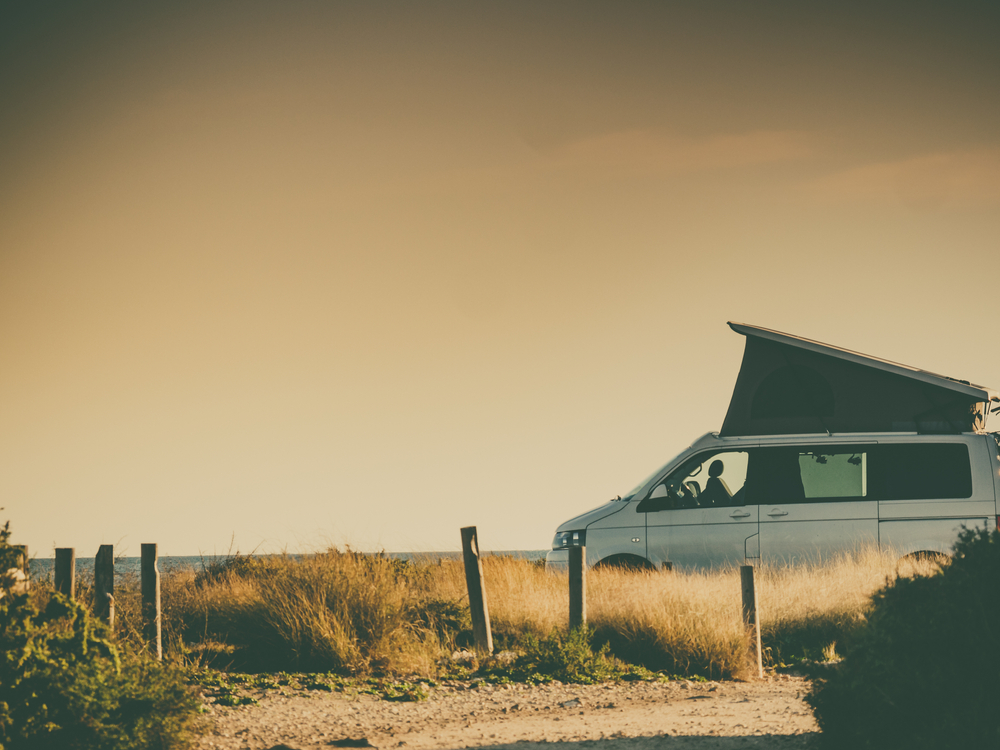
Soft shell roof top tents have two key advantages: space and price.
Unlike their hard shell counterparts, you can fold the flooring of a soft shell tent out over the left or right-hand side of the vehicle, effectively allowing you to double the space. For traveling families or anyone camping with a bigger group than two, that extra space is a must.
As soft shell tents don’t have the dual protective layer on the top and the bottom, they’re significantly cheaper to manufacture than hard shell models, and the savings are passed on to the consumer. Soft shell tents can cost hundreds, sometimes even thousands of dollars less than a similar-sized hard shell tent, making them ideal for budget-minded campers.
On the downside, soft shell tents are a bit of a pain to assemble. You’ll need to roll up and pack down vast swathes of fabric and install support beams to secure everything in place.
The Benefits of a Hard Shell Roof Top Tent

In case you’re still wondering what all the fuss is about, here are six key reasons why hard shell roof top tents are the ultimate camping accessory.
- You’re up off the ground: Unlike a conventional tent, a roof top tent has you sleeping on top of your car and high above the ground. That way, you don’t need to worry about animals, rocks, insects, mud, or snow, and you’re less likely to track filth into your bed.
- Easy to set up: Forget about unfurling a tent and hammering pegs into the ground; hard shell roof top tents are much easier to assemble than standard tents and even the soft shell variety. All you have to do is lift up the struts and attach the ladder.
- Plenty of air-flow: As roof top tents are elevated off the ground, the breeze will circulate through the cabin to keep you comfortable and cool. Should it start blowing a gale, you can shelter yourself by closing the fly.
- Durable design: A rugged design means hard shell roof top tents are built to last and able to withstand adverse weather conditions. Although you’ll spend a fair chunk of cash up front, you can expect your purchase to last for many years to come.
- Comfort: Hard shell roof top tents come with a comfy thick mattress that have plenty of padding for a good night’s sleep. Rigid materials provide extra insulation to regulate temperature and hold up well in heavy winds, resulting in less noisy rustling at night.
- Storage: Many hard shell roof top tents allow you to add storage containers on top, which you don’t need to move around when you pop up the tent. Some even allow you to remove the tent entirely and use the hard shell as dedicated storage.
The Disadvantages of a Hard Shell Roof Top Tent
Every camping setup has pros and cons, so it’s worth pointing out a few of the disadvantages of the hard shell roof top tent.
- Price: The hard shell roof top tents we recommend on our list range from $1,200 to $4,000, a sizable sum compared to conventional ground-based tents. Roof top hard shells are substantially more expensive than soft shell tents as well.
- Bathroom access: Climbing out of a roof top tent—whether hard shell or soft shell—in the middle of the night to pee is a bit of a chore. It’s also a little bit laborious to lug all the stuff you need for the evening up and down the ladder.
- Space: Even the biggest hard shell roof top tents aren’t as spacious as the fold-out soft shell options. And when you compare them to conventional tents, RVs, and trailers, roof top tents are downright tiny.
- Weight limitations: You can only safely support so much weight on your roof and racks. Depending on your vehicle, roof top camping might not be viable at all. Remember to factor in the weight of the tent and its contents when doing the math.
The Different Types of Hard Shell Roof Top Tents
Hard shell roof top tents come in two unique styles—pop-up and wedge—each with distinct pros and cons.
Wedge-Style Hard Shell Roof Top Tents
Wedge-style tents have a hinge on the front of the vehicle where you’ll rest your feet, and a crank on the back that lifts the tent vertically to give you plenty of headroom. As the crank is less complex than the rising mechanism of a pop-up, it takes up less room and leaves the camper with more square inches of floor space. However, because the front end around your feet isn’t raised, wedge-style tents can feel a little more cramped.
A big advantage of the wedge-style design is its triangular shape works well in inclement weather. Rain and snow slide down the roof rather than accumulating on the top, and its aerodynamic shape fares better in heavy winds.
Pop-Up Style Hard Shell Roof Top Tents
As you probably guessed from the name, pop-up tents can be quickly erected in a vertical motion, a simple process achieved by unhitching the gas-pressure struts. The result is a box-shaped tent with an evenly leveled roof across the entire area, which creates a feeling of extra space. Although they feel roomier due to the high ceiling, it’s crucial to note wedge-style tents tend to have more square inches of floor space.
Pop-ups are super simple to set up, but their rigid, box-like profile aren’t as effective at deflecting the wind and the rain.
Setting up and Packing Down a Hard Shell Roof Top Tent
Convenience is the core advantage of opting for a hard shell roof top tent, and there’s no denying the innovative design is incredibly easy to set up and pack down.
The process varies a bit between types and models, but the core steps are mainly the same:
- Crank up or unhinge the automatic pop-up feature to allow the tent to rise
- Attach all the relevant fasteners and cords to secure the tent in place
- Put the ladder in at the doorway and clip it in
To pack down a hard shell pop up tent, simply do the same process in reverse.
Setting up and packing down a hard shell roof top tent generally takes 1-2 minutes, making it the quickest and easiest form of tent camping on the market. Compare that to soft shell roof top tents, which take up to 8 minutes to set up or pack down, depending on the model and the complexity of its vestibules.
If you’re wondering whether the extra 5-6 minutes you save using a hard shell is worth it, for us—and for thousands of other happy campers out there—it certainly is. The ability to erect your accommodation in almost an instant is a massive luxury on the road, and the uber-fast process is especially handy when it’s dark or rainy outside. Considering most of the time, you’ll have to set up and pack down your tent on the same day; the added convenience goes a long way.
Maintaining a Hard Shell Roof Top Tent
Given they’re such a substantial investment, it makes financial sense to take the time to care for your hard shell roof top tent properly. Keep the following maintenance tips in mind to ensure your tent lasts the test of time.
- Dry it out: Mold can wreak havoc on a roof top tent, just as it does on ground-based models. After a wet camping trip, erect your tent and let it thoroughly dry out in the sun. It’s okay to pack down your tent while it’s wet, but don’t allow it to sit there and soak for too long.
- Keep it clean: A tough hard bristled brush and/or vacuum cleaner will do to get the dirt, bugs, and organic matter out of your tent. If you want to give it a deep clean, try using soapy water and a sponge (remember to let it dry off properly).
- Oil the hinges: Rain and dew will cause the hinges and cranking mechanism to rust over time. Offset the issue by oiling them regularly with an appropriate silicone lubricant.
- Waterproof the material: Although the material used to construct a hard shell roof top tent has already been waterproofed, it may lose its non-porous properties over time. Periodically applying a coat of waterproofing spray will keep the rain at bay for years to come.
- Scrape the snow off the roof: The bottom section of a roof top tent is designed to support an enormous amount of weight. But the roof? Not so much. If it’s been snowing heavily, scrape the snow off the top to avoid overburdening it.
Hard Shell Roof Top Tent FAQs
If you’ve read this far and still have questions about the hard shell roof top tent, there’s a good chance you’ll find answers below.
What Is the Best Hard Shell Roof Top Tent?
The best hard shell roof top tent is subjective; it ultimately depends on your personal camping preference and budget. In our guide, we rate the best budget, premium, and overall product to help you identify the best option for you.
What Is the Biggest Hard Shell Roof Top Tent?
The biggest hard shell roof top tend that we recommend is the iKamper SkyCamp 2.0, which comes in at a roomy 83 x 86 x 43 inches when open. If you need more space than that, consider opting for a soft shell option instead, which can fold out to create stacks of extra space.
Why Are Hard Shell Roof Top Tents So Expensive?
Hard shell roof top tents are built from high-grade materials designed to withstand the elements, and the fact they must pack down into an aerodynamic shell adds significantly to the cost (the gas-pressure struts alone are super high-tech). Furthermore, the product is still fairly niche, which means there aren’t all that many manufacturers competing on price.
Is a Hard Shell Roof Top Tent Worth It?
We certainly think so. Hard shell roof top tents let you set up camp in mere minutes, a godsend when you’re exhausted after a long drive or it’s raining outside. The process is so simple you can even do it in the pitch dark.
We also love being able to camp up off the ground; no more worrying about rocks or mud.
How Many People Can a Hard Shell Roof Top Tent Fit?
Most hard shell roof top tents are designed to comfortably accommodate two campers, or three with a bit of a squeeze. Some models can fit more in, although you’ll need a larger-than-normal vehicle to support the size and weight.
Can I Use a Hard Shell Roof Top Tent on My Car?
Hard shell roof top tents are commonly found on SUVs, although it is possible to use some models on smaller cars as well. It’s worth checking how much weight your car roof can support with the manufacturer. You’ll also need roof racks that are designed to hold the relevant weight, which may mean swapping out your current ones for an after-market model.
What Sort of Weather Can a Hard Shell Roof Top Tent Withstand?
Their durable design makes hard shell roof top tents among the sturdiest tent types on the market, meaning they hold up well in inclement weather—thick materials and a robust structure will protect you from heavy rain, wind, and snow. You should feel snug and comfortable inside your tent in anything short of gale-force winds, especially if you’ve got a wedge-style tent, which are exceptionally weather-resistant.
Hard Shell Roof Top Tents: The Ultimate Camping Accessory
Now that you’re up to speed on everything there is to know about the world of roof top camping, it’s time to pick out the appropriate hard shell model for your needs.
Carefully sift through the things to consider to determine your individual needs, then work your way through our top eight recommendations to find the ideal option for you.
Once you’ve installed a hard shell roof top tent on your ride, all that’s left to do is hit the road and start making the most of America’s epic natural splendor. Happy camping, folks.
